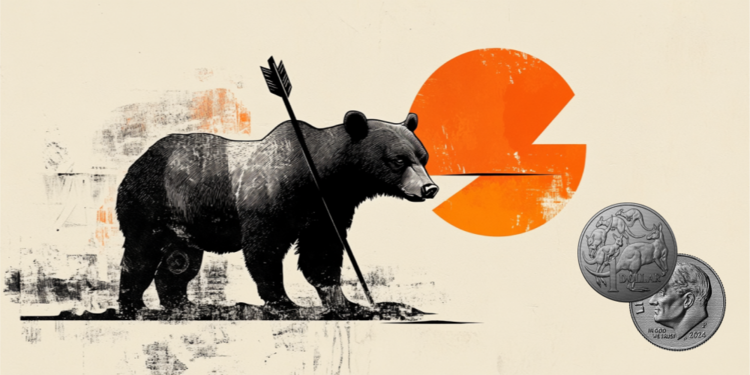It has been almost two months since Russian forces began their attack on the city of Severodonetsk. But despite overwhelming firepower, they still cannot dislodge determined Ukrainian resistance — nor cut the supply lines that provide the city’s remaining defenders with a trickle of weapons and ammunition.
The fierce Ukrainian defense of Severodonetsk, despite heavy losses, forced the Russians to concentrate firepower in a relatively small area and halted their efforts to seize the 10% of the Luhansk region they still do not control.
Russian President Vladimir Putin has declared the seizure of the Luhansk and Donetsk regions of eastern Ukraine as one of the objectives of Moscow’s special military operation that began in February. For the time being, this operation is largely stalled; a large part of Donetsk remains beyond Russian reach.
Russian forces are making modest gains – the Russian Defense Ministry said on Sunday that the town of Metelkino, southeast of Severodonetsk, had been taken. But the Russians’ goal of encircling Ukrainian troops defending the twin cities of Lysychansk and Severodonetsk still seems distant.
In a campaign lacking in agility and imagination, the Russians resorted to one main tactic: crushing indirect fire against any and all Ukrainian positions, regardless of collateral destruction.
The goal is to leave nothing standing that can be defended. The use of ground troops to seize and hold urban areas has been less frequent and less successful.
In a video of Ukrainian special forces in the area released over the weekend, an unidentified Ukrainian soldier says: “They are throwing everything they have, all the ammunition they have. It doesn’t matter to them if it’s our positions or civilian areas, they wipe everything off the face of the Earth and then they use artillery and then they start advancing little by little.”
Amid intense urban fighting, around 500 civilians, including dozens of children, took shelter at the Azot chemical factory in Severodonetsk. Unlike the Azovstal factory in Mariupol, it offers little protection below ground. Ukrainian officials say people there, who previously refused to leave, have food supplies but can no longer be evacuated from the factory because of the intense fighting.
But like Azovstal, the Azot factory and its immediate surroundings became the focal point of Ukrainian resistance—thwarting Russian commanders.

According to studies by the Institute for the Study of War (ISW) in Washington, “Russian troops are likely to face increasing losses and degradation of troops and equipment that will complicate attempts to renew offensive operations in other critical locations as the war continues.” slow battle for Severodonetsk continues”.
Just as Mariupol’s defense attracted more than a dozen tactical battalion groups, overcoming resistance in Severodonetsk is proving to be difficult.
Resistance
The Ukrainians claim to have inflicted heavy losses on Russian forces in the area — thanks in part to new equipment from Western allies, including anti-tank weapons and long-range howitzers supplied by the United States and France.
On Saturday, the Ukrainian armed forces claimed that units of Russia’s 11th Separate Motorized Rifle Regiment had suffered significant losses and were “withdrawn from the area of combat operations to restore combat capability”.
However, Ukrainian supply lines are under constant attack, and it has become more difficult to transport supplies from the west of the Donetsk region along the road to Lysychansk.
The ISW still expects that “Russian forces will likely be able to take Severodonetsk in the coming weeks, but at the cost of concentrating most of their available forces in this small area.”
The Russians’ tactics so far suggest a campaign to crush resistance south of the city — in places like Syrotyne — and then attack Ukrainian defenses from various directions.
Ukrainian officials say the Russians are increasingly using drones to identify their defensive positions. “The Russian military monitors the air day and night with drones, adjusts firepower and quickly adapts to our changes in defensive areas,” said Serhii Hayday, head of the Luhansk regional military administration.

Elsewhere along an active frontline stretching over 1,000 kilometers, little territory is currently ceded or taken.
The Russians’ main objectives in Donbass are to seize the industrial city and transport hub of Sloviansk and the city of Bakhmut, both in Donetsk — but they have made very limited progress on either objective. They may also be vulnerable to Ukrainian counterattacks south and west of the city of Izium.
Southern Ukraine represents a different picture. The Russians appear to be consolidating the gains made in the early days of the war along lines that allow them to defend a coastal belt in depth.
Ukrainian counter-attacks towards the town of Kherson have made limited progress as the Russians are now well entrenched and show little appetite for trying to conquer more territory.
As UK Prime Minister Boris Johnson said on Sunday after his second visit to Kiev: “Time is of the essence. It will all depend on whether Ukraine can strengthen its ability to defend its soil faster than Russia can renew its attack capability.”
fragile morals
Some of Ukraine’s best military units were punished during the defense of Donbass. Defense Minister Oleksiy Reznikov told CNN in the past week that tens of thousands of Ukrainians have been killed since the Russian invasion began on February 24. Probably the vast majority are soldiers.
The UK Ministry of Defense assessed this weekend that Ukrainian forces had likely suffered defections in recent weeks – although it believes Russian morale is much more fragile.
So it’s not just about providing accurate long-range weapons to the Ukrainian forces, but also about stepping up training. Johnson is promoting a plan whereby the Allies develop the potential to train up to 10,000 soldiers every 120 days.
Despite their losses, and even when they deploy old T62 tanks in some places, Russian forces maintain enormous superiority in tanks and fighter aviation. And despite a thoughtful and predictable strategy, they can continue to tear down Ukrainian defenses. A video emerged over the weekend revealing the scale of the destruction at Lyman, near Sloviansk, as Popasna and Rubizhne further east were razed in April.
But with an accelerating flow of weapons capable of diminishing Russia’s advantage in heavy artillery and rocket systems, Ukrainian forces can still prevent the enemy from inflicting such devastation on more towns and cities further west.
Source: CNN Brasil
I’m Susan Karen, a professional writer and editor at World Stock Market. I specialize in Entertainment news, writing stories that keep readers informed on all the latest developments in the industry. With over five years of experience in creating engaging content and copywriting for various media outlets, I have grown to become an invaluable asset to any team.







